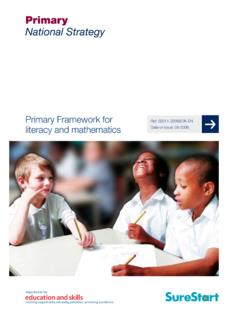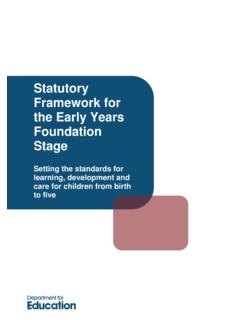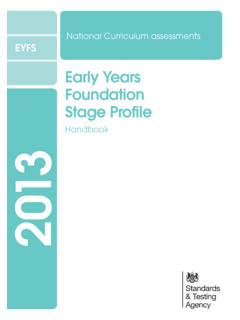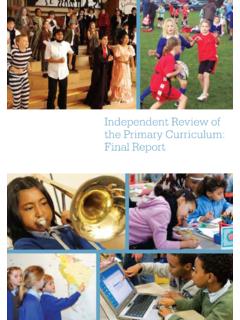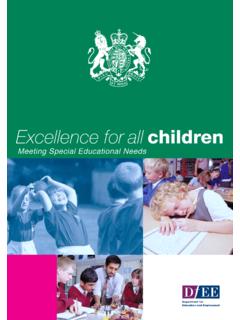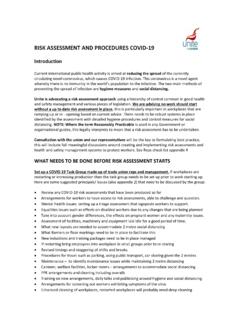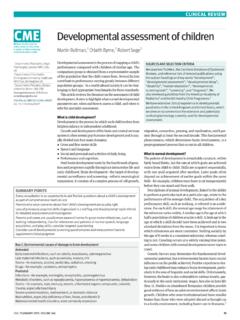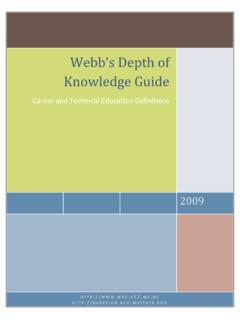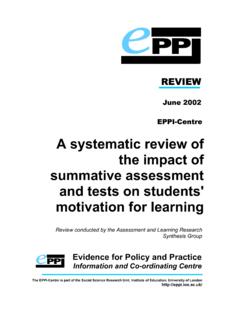Transcription of National Curriculum Task Group on Assessment and Testing
1 National Curriculum Task Group on Assessment and Testing A Report Department of Education and Science and the Welsh Office REPORT OF THE TASK Group ON Assessment AND Testing CONTENTS Preface and Glossary Letter to the Secretary of State Sections of Main Report: Paragraphs: INTRODUCTION I. Our starting point 1 - 6 II. Present practice 7 -12 III. Concerns to be addressed 13 - 19 IV. The structure of the report 20 - 22 PURPOSES AND PRINCIPLES V. Purposes 23 - 30 VI. Profile components in the Assessment framework 31 - 39 VII. Assessment and Testing methods 40 - 50 VIII. Bias in assessments 51 - 53 IX. Ensuring confidence in National Assessment 54 - 63 X. Moderation 64 - 90 THE Assessment SYSTEM IN PRACTICE XI.
2 Progression, scales and ages 91 - 124 XII. Reporting 125 - 138 XIII. The primary stage 139 - 157 XIV. The secondary stage 158 - 167 XV. The Assessment of children with special educational needs 168 - 173 IMPLEMENTATION XVI. The brief for the subject groups 174 - 188 XVII. Phasing 189 - 199 A SYSTEM OF SUPPORT XVIII. The support structure 200 - 205 XIX. Inset and other resource needs 206 - 214 XX. The local education authority's role 215 - 217 XXI. Future work for the task Group 218 SUMMARY AND CONCLUSIONS XXII. Conclusions 219 - 226 XXIII. A List of Recommendations 227 PREFACE AND GLOSSARY This report of the Task Group on Assessment and Testing ventures into a specialised field with its own technical vocabulary.
3 We have tried to avoid technical jargon wherever possible, but it has sometimes been necessary to use terms which are unfamiliar to the layman or whose meaning here is different from that of everyday usage. We explain some of these terms below. Others are explained where they first appear in the report - including those we have specially coined to label ideas newly devised by the Group Assessment A general term enhancing all methods customarily used to appraise performance of an individual pupil or a Group . It may refer to a broad appraisal including many sources of evidence and many aspects of a pupil's knowledge, understanding, skills and attitudes; or to a particular occasion or instrument. An Assessment instrument may be any method or procedure, formal or informal, for producing information about pupils: a written test paper, an interview schedule, a measurement task using equipment, a class quiz.
4 Test Strictly, any Assessment conducted within formal and specified procedures, designed to ensure comparability of results between different test administrators and between different test occasions. For some it implies a set of written questions, externally prescribed, with written responses marked according to rigid rules; for others, any of a broad range of Assessment instruments with standardised rules of administration and marking which ensure comparability of results. This report uses the term in the latter, broader sense. Tests intended for widespread use are commonly pilot-tested with a representative National sample. A standardised test is one published with marking instructions and data on the levels of response established for a National population sample, at a given age, or with different data for several ages.
5 tasks and projects A task is any activity in which a pupil takes part and which could be used for Assessment . Examples are a written test, an essay, a practical job such as designing or constructing an artefact, or conducting an experiment. tasks which are open-ended and extensive in scope and/or in time are often called projects: these may require independent planning and/or research on the part of the pupil. Item bank An orderly collection of test questions or tasks , so assembled and labelled that users may select from it sets of tasks for particular Assessment purposes. Those in charge of such a bank usually exert quality control on the questions put in it. Ranking, rating and marking Ranking involves putting pupils' performances in order of relative quality.
6 The set of rankings forms a scale. Where a scale simply has some order, it may be called a ranking scale. If the order is related to given criteria, it may be called a rating scale. Different performances are often assigned numerical marks and the marks added. The numbers may then be treated like measurements of length or weight, as if, for example, 50 marks represented twice the performance of 25 marks. Mark scales can be misleading in this respect. Norm-referencing An Assessment system in which pupils are placed in rank order and pre-determined proportions are placed in the various grades. It implies that the grade given to a particular pupil depends upon a comparison between that pupil's performance and those of all the other pupils in the Group , rather than upon the absolute quality of the performance.
7 Criterion-referencing As defined for this report, an Assessment system in which an award or grade is made on the basis of the quality of the performance of a pupil irrespective of the performance of other pupils: this implies that teachers and pupils be given clear descriptions of the performances being sought. This is a broader and less exacting definition than that used by some authors. Aggregation Combining a pupil's marks or grades on a set of different Assessment items to give a single mark or grade. This may be done in different ways: for example, two numerical marks may be added together, or two grades may be combined according to rules ( AA, AB or BA all give a complete A). Level In this report, level indicates achievement of a particular set of performance criteria which have been defined within a "profile component" (see section VI), or cluster of attainment targets.
8 In general, a higher level will imply achievement of greater sophistication or range than that for a lower level. Grades Different qualities of response to a common Assessment demand or task. "Pass/fail" examinations are usually referred to as ungraded. Criterion-referenced assessments are "pass/fail" insofar as pupils' performances are judged with respect to unitary criteria. The equivalents to grades in a criterion-referenced system are results summed over the attainment target criteria, so that success is judged relative to those attainment targets which have been met. In this report we distinguish between the quality of response to the same attainment targets (grades), and the degrees of success in reaching a collection of attainment targets (levels).
9 Moderation The process of checking comparability of different assessors' judgements of different groups of pupils. The term can also refer to a procedure for determining a single set of marks or ratings when two sets are available for the same pupils on the same profile components, one set from a teacher's course assessments and one from a National test. One set (usually the teachers') may be adjusted to give the same mean and spread as the other. This is a statistical operation usually called scaling. There are other forms of statistical moderation: for example, when the "results" are expressed as grouped percentage distributions of pupils, adjustments can involve deciding which borderline pupils should change their Group status.
10 This can be a more sensitive procedure than scaling. Calibration Where procedures for equating results of the assessments are statistical, the procedure is sometimes called calibration, to distinguish from procedures in which the judgement of assessors is involved (moderation). This scaling is a form of calibration. Procedures using both statistical data and judgements are sometimes called "intelligent statistical moderation". Skill Ability to perform, usually acquired by training: can be displayed in many types of performance, manual, craft, design, communication, observation, measurement. Concept A generalised idea or notion; identifying something as an example of a particular concept enables one to infer how to treat it. Knowledge That which is known in an ordered way and can be used; in this sense different from just a collection of unrelated information.

